Easiest brew day ever!
I've been wanting to make mead for a while now, and have been researching it. It sounds easy, except for the waiting: a plurality of months, the more aging the better (within limits)...
I got the yeast and nutrients - required for mead, since yeast cannot thrive on sugars alone - a while back, when I started planning this out. Of course, I always have a large supply of my brewing water (erm, that would be Crystal Geyser; yeah, the bottled string water) in reserve, in case the whim hits me to brew. So that just left the most important ingredient: the honey... (That's debatable, as some might argue that the yeast is more important, although of course both are required...)
Most "honey" that you see in the mass markets is, of course,
not actually real honey. Typically it will be heavily diluted with - I bet you can guess? - high fructose corn syrup. The FDA dictates that any product that does not contain pollen cannot be called "honey", i.e. that "honey" must contain pollen. But it doesn't dictate how much. And it doesn't dictate that the product actually has to come from bees. And the FDA is understaffed anyways. So the net result? In a test by Texas A&M, none of the honey found in fast food restaurants contained any pollen, and 76% of the stuff listed on supermarket shelves as "honey" was also devoid of pollen; furthermore, most of it was sourced from China, rather than locally. Some of this lack of pollen is due to heavy filtering, but much of it is also due to "augmentation" with corn syrup.
On the other hand, of the tested samples from farmers markets, coops and health stores, all samples contained local pollen indicating it was sourced from bees in local apiaries. I decided to seek out local honey producers. I started online, but found a real dearth of online data about local honey producers. So I went down to the local (Westside Santa Cruz) farmers market, where I met Kate from
R&K Honeybees, located up in the Santa Cruz Mountains near Boulder Creek. I bought some tasters of orange blossom, blackberry and star thistle, which all seemed like good varieties to start with (lots of mead is made from orange blossom honey). They were quite delicious, and of course were raw, unfiltered and unpasteurized. In conversing with Kate, I discovered that they do sell in larger batches, so I can scale up to 5- or 10-gallon batches in the future, and get a price break. She didn't have the quantities on hand that I would need, unfortunately. I had decided I wanted to do some initial small-quantity batches of 1-gallon each, since I have some 1-gallon carboys left over from my cider experiments last year. For a 1-gallon batch, you need 3 pounds of honey, which is roughly 32 fluid ounces.
After some back-and-forth (and lost emails), I finally procured some honey from Kate, who kindly drove down on a Saturday from Boulder Creek to Ben Lomond to meet me half way. I bought four 32-fluid-ounce jars: three of orange blossom, and one of blackberry. I had originally wanted one of star thistle as well, but she was out of star thistle.
In my research into mead-making, I kept coming across this recipe that people rave about for first-time meadists called JAOM, which stands for "Joe's Ancient Orange Mead". It's a
super-simple recipe, introduces adjuncts of oranges, raisins, a cinnamon stick and a (single) clove, and uses (gasp) bread yeast. I thought I'd give it a try, along with my other test batches. I decided to do four batches: 1) JAOM, 2) orange blossom honey with D47 yeast, 3) blackberry honey with D47 yeast, and 4) orange blossom honey with 71B-1122 yeast. The D47 and 1122 yeast strains appear to be the most popular strains for mead making, and D47 leaves a sweeter finish, which I think will work well for people's expectations of a mead.
So I had everything I needed. Mostly... I was missing the adjuncts for the JAOM and the bread yeast as well, so I got up early (for most people) on Monday (labour day, a holiday here in the states) and went to Safeway (ick!) for those ingredients. Part of my goal with the JAOM is to make it using off-the-shelf ingredients, since that is the spirit of JAOM, and also appeals to my post-apocalyptic scavenging theme. Janky mead it may be; we'll see how it comes out...
To make the honey more manageable, I warmed the jars in 100°F+ water. You have to be careful with honey that you don't overheat it, as that loses a lot of the character, flavour and aromatics of the honey. Consensus seems to be that you don't want to go much above 40°C, so that's about 104°F. This temperature also carried over as the dissolving temperature, but more on that later. Once warmed in the jar, the honey is much more easily manipulated, and flows our of the jar more easily, leaving less residual in the jar, and more in the "must" (which is the term for the mead equivalent of wort, i.e. the pre-yeasted mixture).
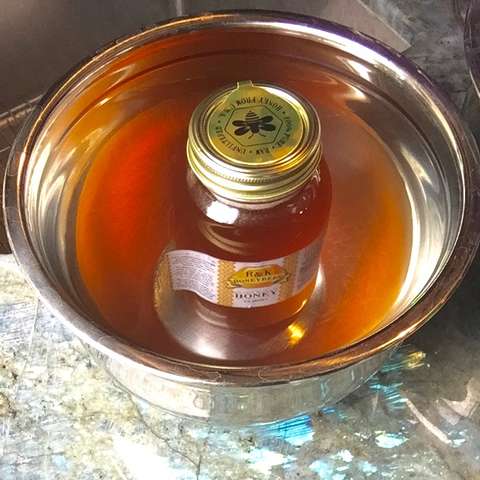
I heated about a half-gallon of water in a pot (again, to just over 100°F), and poured the honey in, and then stirred it with a (sanitized) spoon to dissolve it in the water.
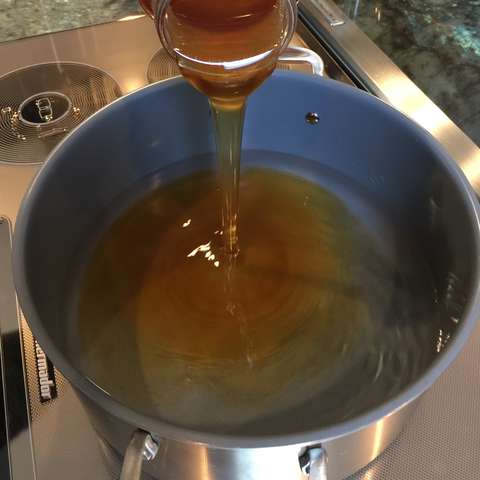
Once that was done, I poured it through a (sanitized) funnel into a (sanitized) 1-gallon carboy. I would then stopper the carboy, vigourously shake it to aerate the must, take a hydrometer reading, and then pitch the yeast and put an airlock on the carboy.
And that's basically it...
Well, kinda...
For the JAOM, the adjuncts needed to be prepared, and added. I washed the orange (well!), doused it with vodka to nuke any germs, cut it into eighth wedges, stuck them in (sanitized) hop socks, and jammed those into the carboy prior to the must. I also soaked the raisins, cinnamon and clove in vodka to sanitize it, and then added them (less the vodka) to the carboy. I poured the must on top of this, and added the bread yeast dry (as the recipe says to do, surprisingly).

For the others, the yeast needs to be hydrated, so I would add a bit of the water with just lightly-dissolved honey (before fully-dissolving it) to a dish, add the yeast, and let it rehydrate in that.
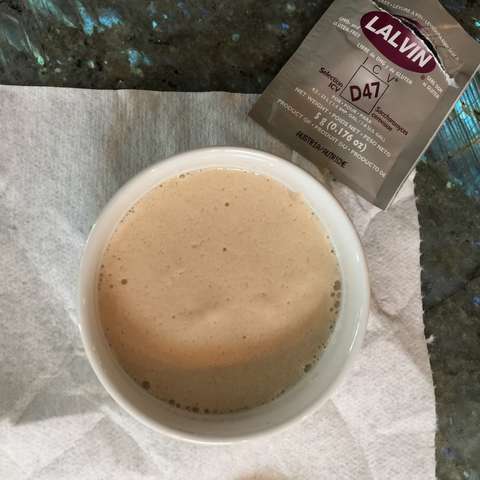
I am certain I over-pitched, because I used a whole packet of dry yeast, but we shall see.
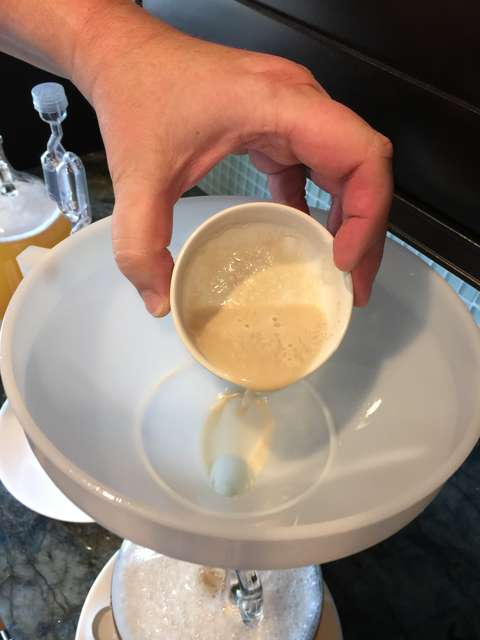
Oh, and then there are the yeast nutrients... Like people, yeast cannot subsist on sugars alone, they also need nutrients, notably nitrogens. In beer-making, this is mostly obtained through the wort, and I've never had to add yeast nutrients whilst brewing beer. But for honey, the must is basically pure sugars, and the alcohol levels are higher, so - like wine - the yeast strains used need some extra help. This comes in the form of DAP (diammonium phosphate) and Fermaid-K, which is basically dead yeast cells (so I guess yeast are a bit cannibalistic). I used my hop scales, and bindles of parchment paper (I had to google how to make a bindle), to prep nutrient packets ahead of time.
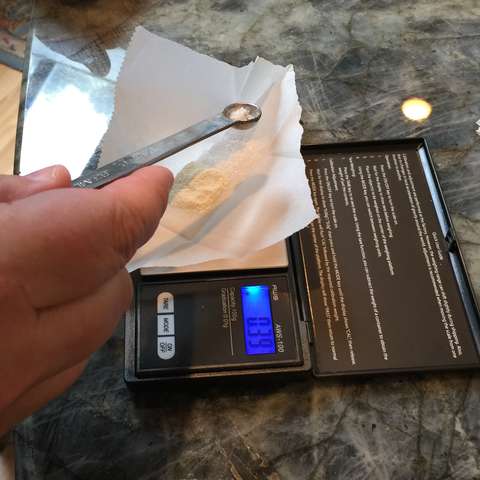
(Since there is nothing at all suspicious-looking about paper bindles filled with powdery substance, I put them in a zip-lock upon which I wrote with a sharpie the weights and contents...)
I added one at pitch, and will add another tomorrow, and another when I estimate 1/3 of the sugar has been consumed.
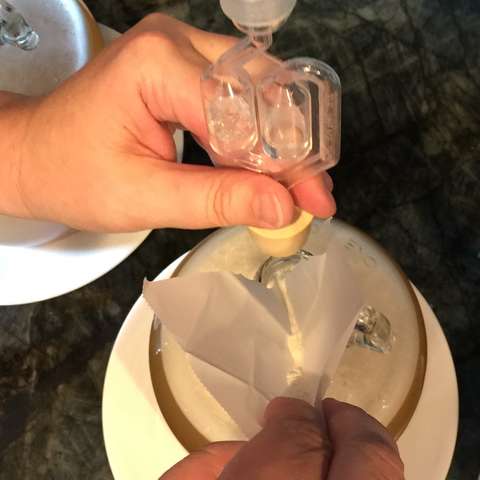
Other than that, some of the usual elements of brewing surfaced in mead-making as well: keeping things sanitized with StarSan, making sure to take hydrometer readings, and of course the inevitable washing up.
By the time I was done with the washing up, the JAOM had been vigourously bubbling for a while... Bread yeast, yeah, that's a thing...
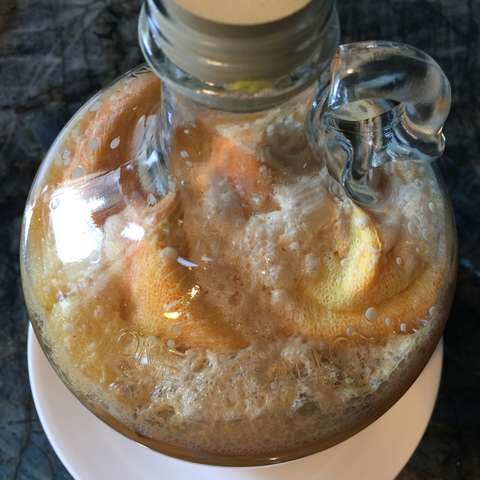
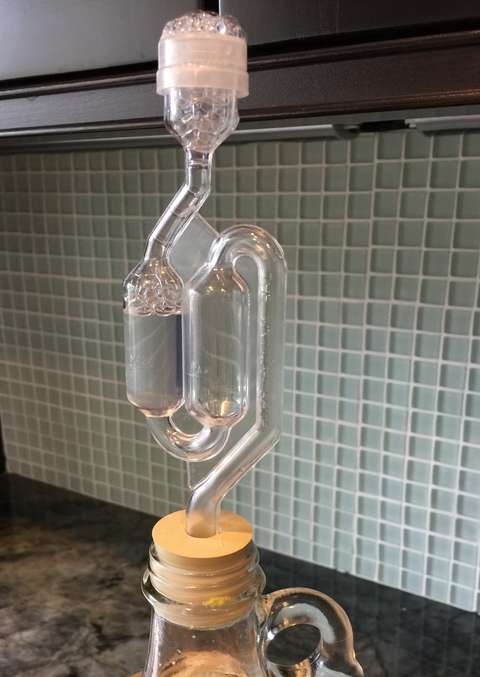
Still, this was super-easy compared to a typical brew day, and I have 4 mini batches to compare.
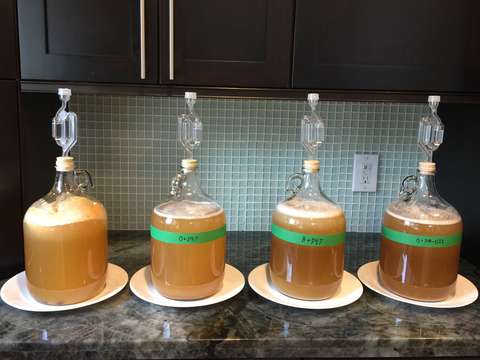
Now I just have to wait...
"The waiting is the hardest part." - Tom Petty
#Mead #BrewDay #GlutenFree

 I heated about a half-gallon of water in a pot (again, to just over 100°F), and poured the honey in, and then stirred it with a (sanitized) spoon to dissolve it in the water.
I heated about a half-gallon of water in a pot (again, to just over 100°F), and poured the honey in, and then stirred it with a (sanitized) spoon to dissolve it in the water.
 Once that was done, I poured it through a (sanitized) funnel into a (sanitized) 1-gallon carboy. I would then stopper the carboy, vigourously shake it to aerate the must, take a hydrometer reading, and then pitch the yeast and put an airlock on the carboy.
And that's basically it...
Well, kinda...
For the JAOM, the adjuncts needed to be prepared, and added. I washed the orange (well!), doused it with vodka to nuke any germs, cut it into eighth wedges, stuck them in (sanitized) hop socks, and jammed those into the carboy prior to the must. I also soaked the raisins, cinnamon and clove in vodka to sanitize it, and then added them (less the vodka) to the carboy. I poured the must on top of this, and added the bread yeast dry (as the recipe says to do, surprisingly).
Once that was done, I poured it through a (sanitized) funnel into a (sanitized) 1-gallon carboy. I would then stopper the carboy, vigourously shake it to aerate the must, take a hydrometer reading, and then pitch the yeast and put an airlock on the carboy.
And that's basically it...
Well, kinda...
For the JAOM, the adjuncts needed to be prepared, and added. I washed the orange (well!), doused it with vodka to nuke any germs, cut it into eighth wedges, stuck them in (sanitized) hop socks, and jammed those into the carboy prior to the must. I also soaked the raisins, cinnamon and clove in vodka to sanitize it, and then added them (less the vodka) to the carboy. I poured the must on top of this, and added the bread yeast dry (as the recipe says to do, surprisingly).
 For the others, the yeast needs to be hydrated, so I would add a bit of the water with just lightly-dissolved honey (before fully-dissolving it) to a dish, add the yeast, and let it rehydrate in that.
For the others, the yeast needs to be hydrated, so I would add a bit of the water with just lightly-dissolved honey (before fully-dissolving it) to a dish, add the yeast, and let it rehydrate in that.
 I am certain I over-pitched, because I used a whole packet of dry yeast, but we shall see.
I am certain I over-pitched, because I used a whole packet of dry yeast, but we shall see.
 Oh, and then there are the yeast nutrients... Like people, yeast cannot subsist on sugars alone, they also need nutrients, notably nitrogens. In beer-making, this is mostly obtained through the wort, and I've never had to add yeast nutrients whilst brewing beer. But for honey, the must is basically pure sugars, and the alcohol levels are higher, so - like wine - the yeast strains used need some extra help. This comes in the form of DAP (diammonium phosphate) and Fermaid-K, which is basically dead yeast cells (so I guess yeast are a bit cannibalistic). I used my hop scales, and bindles of parchment paper (I had to google how to make a bindle), to prep nutrient packets ahead of time.
Oh, and then there are the yeast nutrients... Like people, yeast cannot subsist on sugars alone, they also need nutrients, notably nitrogens. In beer-making, this is mostly obtained through the wort, and I've never had to add yeast nutrients whilst brewing beer. But for honey, the must is basically pure sugars, and the alcohol levels are higher, so - like wine - the yeast strains used need some extra help. This comes in the form of DAP (diammonium phosphate) and Fermaid-K, which is basically dead yeast cells (so I guess yeast are a bit cannibalistic). I used my hop scales, and bindles of parchment paper (I had to google how to make a bindle), to prep nutrient packets ahead of time.
 (Since there is nothing at all suspicious-looking about paper bindles filled with powdery substance, I put them in a zip-lock upon which I wrote with a sharpie the weights and contents...)
I added one at pitch, and will add another tomorrow, and another when I estimate 1/3 of the sugar has been consumed.
(Since there is nothing at all suspicious-looking about paper bindles filled with powdery substance, I put them in a zip-lock upon which I wrote with a sharpie the weights and contents...)
I added one at pitch, and will add another tomorrow, and another when I estimate 1/3 of the sugar has been consumed.
 Other than that, some of the usual elements of brewing surfaced in mead-making as well: keeping things sanitized with StarSan, making sure to take hydrometer readings, and of course the inevitable washing up.
By the time I was done with the washing up, the JAOM had been vigourously bubbling for a while... Bread yeast, yeah, that's a thing...
Other than that, some of the usual elements of brewing surfaced in mead-making as well: keeping things sanitized with StarSan, making sure to take hydrometer readings, and of course the inevitable washing up.
By the time I was done with the washing up, the JAOM had been vigourously bubbling for a while... Bread yeast, yeah, that's a thing...

 Still, this was super-easy compared to a typical brew day, and I have 4 mini batches to compare.
Still, this was super-easy compared to a typical brew day, and I have 4 mini batches to compare.
 Now I just have to wait...
"The waiting is the hardest part." - Tom Petty
#Mead #BrewDay #GlutenFree
Now I just have to wait...
"The waiting is the hardest part." - Tom Petty
#Mead #BrewDay #GlutenFree